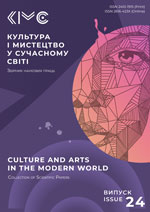Arts’s Fight for Life or the Triumphant End of the Avant-Garde
DOI:
https://doi.org/10.31866/2410-1915.24.2023.287666Keywords:
Avant-guard, experimental art, Fluxus, Marcel Duchamp, Dada, science, revolution, linear perspective, postmodernism, photography, cinema, cubism, abstractionisms, realism, readymadeAbstract
The aim of the article is to outline a logical sequence of events that led to radicalism in the art of the 19th and 20th centuries by studying the connections between art, life (reality), and science and technology. From the mid-nineteenth century through the 1970s, art acquired a unique quality: it rapidly radicalised, creating a number of alternative art practices, such as impressionism, abstractionism, cubism, ready-made, etc. Before that, except for random individual phenomena, art for centuries was just changing styles: Baroque, Rococo, Classicism. Results. The article identifies the cause for the revolutionary avant-garde trends in art and the reason for the end of the revolutionary era. It presents a view based on art’s relations with life in competition with science and technology that had different effects on art, ranging from influentially adaptive to revolutionary rebellious. The scientific significance of this study is its innovative approach to the consideration of factors of the emergence and development of avant-garde trends in the art of the 19th and 20th centuries. The rational study and comparable analyses of events in science/ technology and art in relation to life (reality) offers an inventive and coherent reason for the appearance and disappearance of avant-guard art. Conclusions. This article identifies the cause for the revolutionary avant-garde trends in art and the reason for the end of the revolutionary era. It presents a unique view based on art’s relations with life in competition with science and technology and shows how an inadvertent battle of art for life (reality) with photography, film and television triumphed in the twentieth century and broke the very possibility of further revolutionary changes.
References
Dada at the Museum of Modern Art. (1968, April 8). Newsweek, 71(15), 132 [in English].
Holy Trinity (Masaccio). (2023, May 10). In Wikipedia. https://en.wikipedia.org/wiki/Holy_Trinity_(Masaccio) [in English].
Kandinsky, W. (1912). Über das Geistige in der Kunst [About the spiritual in art] (2nd ed.). Piper and Company [in German].
Popper, F. (1968). Origins and development of Kinetic Art. Studio Vista [in English].
Tomkins, C. (1996). Duchamp: A Biography. Henry Holt [in English].
Tomkins, C. (2013). Marcel Duchamp: The Afternoon interviews. Badlands Unlimited [in English].
Downloads
Published
How to Cite
Issue
Section
License

This work is licensed under a Creative Commons Attribution 4.0 International License.
Authors who publish in this journal agree to the following terms:
1) The authors reserve the right to the authorship of their work and transfer to the journal the right to first publish this work under the terms of the Creative Commons Attribution License, which allows others to freely distribute the published work with a mandatory reference to the authors of the original work and the first publication of the work in this journal.
2) The authors have the right to enter into independent additional agreements for non-exclusive distribution of the work in the form in which it was published by this journal (for example, to place the work in the electronic repository of the institution or to publish it as part of a monograph), provided that the reference to the first publication of the work in this journal is maintained.
3) The journal's policy allows and encourages authors to post their manuscripts on the Internet (for example, in institutional repositories or on personal websites) both before submitting the manuscript to the editorial board and during its editorial processing, as this contributes to the emergence of a productive scientific discussion and has a positive effect on the efficiency and dynamics of citation of published work (see The Effect of Open Access).






